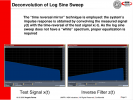I was reviewing the mechanism by which the Klippel NFS derives harmonic distortion measurements, and it appears that it does so simultaneously with the frequency response measurement. In other words, the data derived from the multi-distance measurement set can be used to generate plots of frequency response and harmonic distortion, presumably limited of course by the sample rate.
This raises an interesting possibility, however - the system should be able to show relative harmonic magnitudes as a function of space - distortion directivity. This could be represented in a plot similar to directivity, but showing H2 or H3 or whatever harmonic is desired.
I was wondering one, if @amirm knew if the NFS could generate reports of this data, and two, if anyone had seen any data indicating that HD magnitude changes with respect to measurement position? Obviously, one would expect that at low frequencies, and probably midrange, harmonic distortion would be a stable % of total output, and would 'track' the falloff of the drivers, but I wonder if there could be off-axis peaks in harmonic distortion, produced for example when drivers are entering breakup.
Curious if anyone has seen any data on this. @ctrl, @NTK.
This raises an interesting possibility, however - the system should be able to show relative harmonic magnitudes as a function of space - distortion directivity. This could be represented in a plot similar to directivity, but showing H2 or H3 or whatever harmonic is desired.
I was wondering one, if @amirm knew if the NFS could generate reports of this data, and two, if anyone had seen any data indicating that HD magnitude changes with respect to measurement position? Obviously, one would expect that at low frequencies, and probably midrange, harmonic distortion would be a stable % of total output, and would 'track' the falloff of the drivers, but I wonder if there could be off-axis peaks in harmonic distortion, produced for example when drivers are entering breakup.
Curious if anyone has seen any data on this. @ctrl, @NTK.



